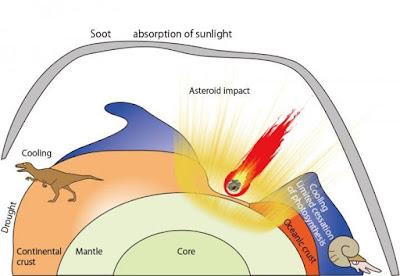 |
| Global climate change caused by soot aerosol at the K-Pg boundary. Credit: Kunio Kaiho |
A new hypothesis on the extinction of dinosaurs and ammonites at the end of the Cretaceous Period has been proposed by a research team from Tohoku University and the Japan Meteorological Agency's Meteorological Research Institute.
The researchers believe that massive amounts of stratospheric soot ejected from rocks following the famous Chicxulub asteroid impact, caused global cooling, drought and limited cessation of photosynthesis in oceans. This, they say, could have been the process that led to the mass extinction of dinosaurs and ammonites.
The asteroid, also known as the Chicxulub impactor, hit Earth some 66 million years ago, causing a crater more than 180 km wide. It's long been believed that that event triggered the mass extinction that led to the macroevolution of mammals and the appearance of humans.
Tohoku University Professor Kunio Kaiho and his team analyzed sedimentary organic molecules from two places -- Haiti, which is near the impact site, and Spain, which is far. They found that the impact layer of both areas have the same composition of combusted organic molecules showing high energy. This, they believe, is the soot from the asteroid crash.
Soot is a strong, light-absorbing aerosol, and Kaiho's team came by their hypothesis by calculating the amount of soot in the stratosphere estimating global climate changes caused by the stratospheric soot aerosols using a global climate model developed at the Meteorological Research Institute. The results are significant because they can explain the pattern of extinction and survival.
While it is widely accepted that the Chicxulub impact caused the mass extinction of dinosaurs and other life forms, researchers have been stumped by the process of how. In other words, they'd figured out the killer, but not the murder weapon.
Earlier theories had suggested that dust from the impact may have blocked the sun, or that sulphates may have contaminated the atmosphere. But researchers say it is unlikely that either phenomenon could have lasted long enough to have driven the extinction.
The new hypothesis raised by Kaiho's team says that soot from hydrocarbons had caused a prolonged period of darkness which led to a drop in atmospheric temperature. The team found direct evidence of hydrocarbon soot in the impact layers and created models showing how this soot would have affected the climate.
According to their study, when the asteroid hit the oil-rich region of Chicxulub, a massive amount of soot was ejected which then spread globally. The soot aerosols caused colder climates at mid-high latitudes, and drought with milder cooling at low latitudes on land. This in turn led to the cessation of photosynthesis in oceans in the first two years, followed by surface-water cooling in oceans in subsequent years.
This rapid climate change is believed to be behind the loss of land and marine creatures over several years, suggesting that rapid global climate change can and did play a major role in driving extinction.
Kaiho's team is studying other mass extinctions in the hopes of further understanding the processes behind them.
***
Source:
The above post is reprinted from materials provided by Tohoku University.
Reference:
Kunio Kaiho, Naga Oshima, Kouji Adachi, Yukimasa Adachi, Takuya Mizukami, Megumu Fujibayashi, Ryosuke Saito. Global climate change driven by soot at the K-Pg boundary as the cause of the mass extinction. Scientific Reports, 2016; 6: 28427 DOI: 10.1038/srep28427



Post A Comment:
0 comments: